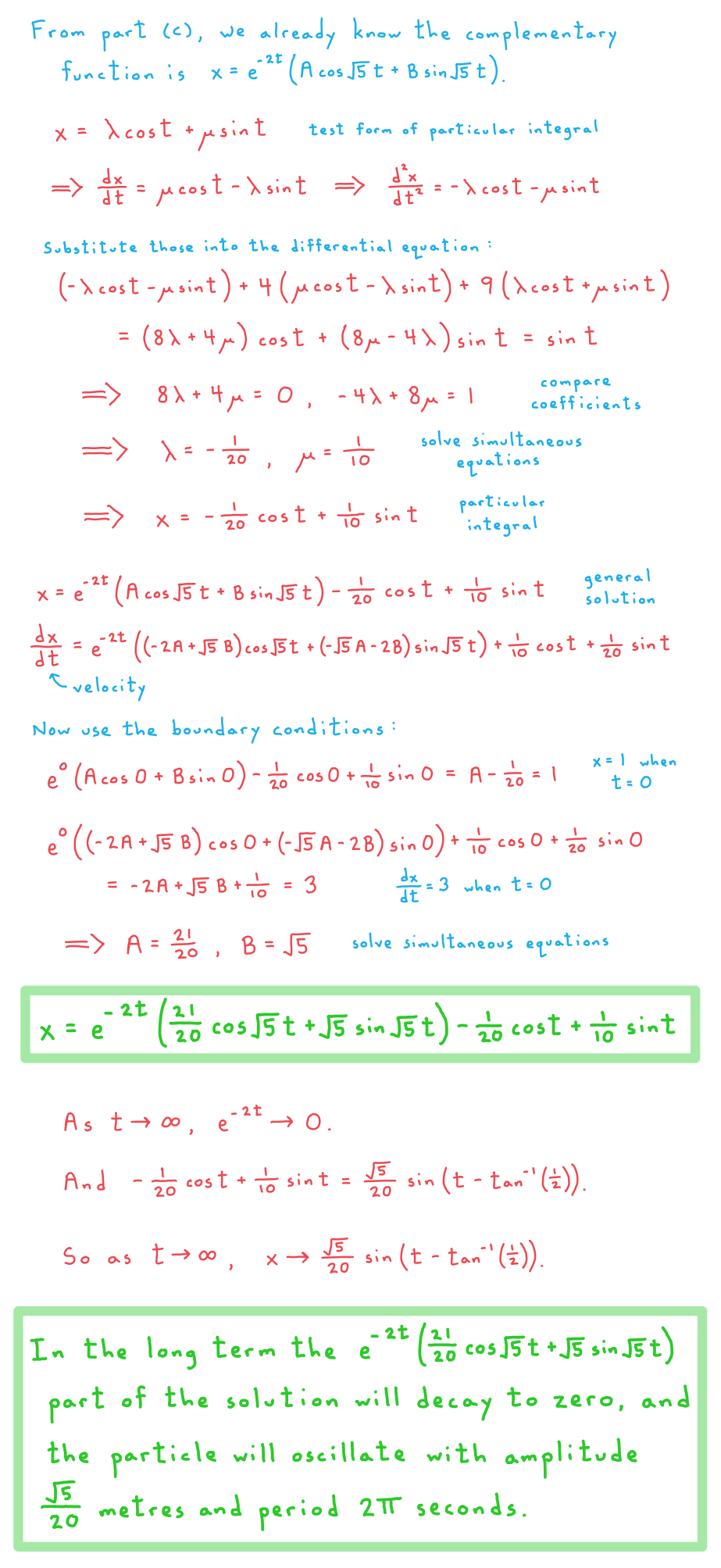Damped or Forced Harmonic Motion (Edexcel A Level Further Maths): Revision Note
Exam code: 9FM0
Damped or forced harmonic motion
What is damped harmonic motion?
If we add a term representing a resistive force to the simple harmonic motion equation, the new equation describes a particle undergoing damped harmonic motion
Depending on the situation being modelled, this resistive force may represent such phenomena as friction or air resistance that resist the motion of the particle
The standard damped harmonic motion equation is of the form
Note that that is the same as the simple harmonic motion equation, except for the addition of the damping term
x is the displacement of the particle from a fixed point O at time t
k is a positive constant representing the strength of the damping force
is a positive constant representing the strength of the restoring force that accelerates the particle back towards point O
The damped harmonic motion equation is a second order homogeneous differential equation, and may be solved using the standard methods for such equations
This will involve using the auxiliary equation to find the complementary function for the equation
You should, however, be familiar with the three main cases:
CASE 1:
The auxiliary equation has two distinct real roots, both of which are negative
This is known as heavy damping (sometimes also referred to as overdamping)
The general solution will be of the form
where α and β are the roots
of the auxiliary equation
Because α and β are both negative, the two exponentials will decay to zero as t increases
Therefore the particle’s displacement will also decay to zero, without any oscillations occurring
However the decay to zero will not happen as quickly as in Case 2 (critical damping) below
CASE 2:
The auxiliary equation has a single repeated root, which is negative
This is known as critical damping
The general solution will be of the form
where
is the repeated root of the auxiliary equation
Because α is negative, the exponential will decay to zero as t increases
Therefore the particle’s displacement will also decay to zero, without any oscillations occurring (although depending on the values of A and B it is possible that the particle will change direction once as the decay to zero occurs
For a given value of
, the displacement of the critical damping case will decay to zero faster than any instance of the heavy damping case
CASE 3:
The auxiliary equation has complex roots which form a complex conjugate pair
This known as light damping (sometimes also referred to as underdamping)
The general solution will be of the form
, where
and
Because p is negative, the exponential will decay to zero as t increases
Therefore the particle’s displacement will also decay to zero
However the cosine and sine terms mean that the particle will continue to oscillate with decreasing amplitude as the decay to zero occurs
In all three cases, initial or boundary conditions given in a question may allow you to work out the precise values of the arbitrary constants A and B
The following displacement-time graph illustrates the behaviour displayed by a particle for each of the three cases

What is forced harmonic motion?
If we add a term representing an external ‘driving’ force to the damped harmonic motion equation, the new equation describes a particle undergoing forced harmonic motion
The standard forced harmonic motion equation is of the form
Note that it is the same as the damped harmonic motion equation, except for the addition of the driving term f(t) on the right-hand side of the equation
x is the displacement of the particle from a fixed point O at time t
k is a non-negative constant representing the strength of the damping force
If k = 0 then there is no damping force
The forced harmonic motion equation is a second order non-homogeneous differential equation, and may be solved using the standard methods for such equations
This will involve using the auxiliary equation to find the complementary function for the equation
It will also involve finding the particular integral for the equation, based on the form of f(t)
Initial or boundary conditions given in a question may allow you to work out the precise values of any arbitrary constants in your general solution
If k ≠ 0 then the long-term behaviour of the system will be predominantly determined by the driving force f(t)
If k = 0, then the long-term behaviour will be a combination of the effects of the driving force and of the system’s natural oscillation
Examiner Tips and Tricks
Even though you may have memorised the forms of the solutions for the damped harmonic motion equation, it is important on an exam question to derive the solution ‘from scratch’, showing your method and working
Worked Example
A particle is moving along a straight line. At time seconds its displacement
metres from a fixed point
is such that
. At time
,
and the velocity of the particle is
ms-1.
(a) Given that , find an expression for the displacement of the particle at time
seconds and describe the type of damping that is present.

(b) Given that , find an expression for the displacement of the particle at time
seconds and describe the type of damping that is present.

(c) Given that k = 4, find an expression for the displacement of the particle at time t seconds and describe the type of damping that is present.

The system is now modified so that at time t seconds the particle’s displacement x metres from the fixed point O is such that . At time t = 0, x = 1 and the velocity of the particle is 3 ms-1.
(d) Find an expression for the displacement of the particle at time t seconds and describe the long-term behaviour of the system.


Unlock more, it's free!
Did this page help you?